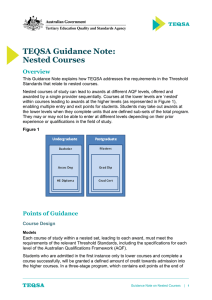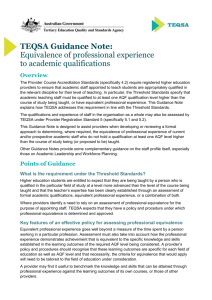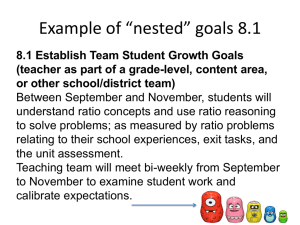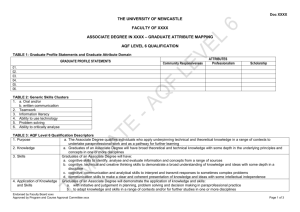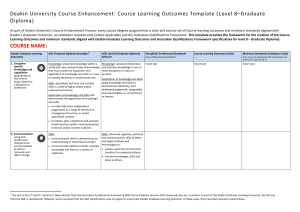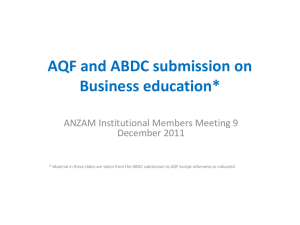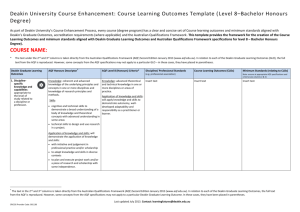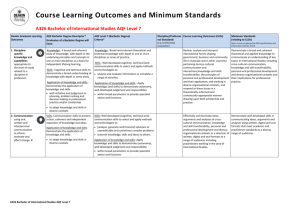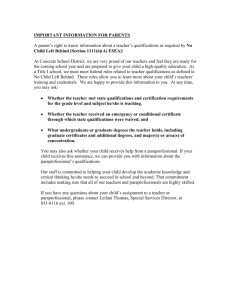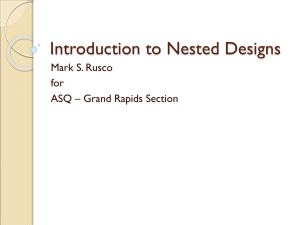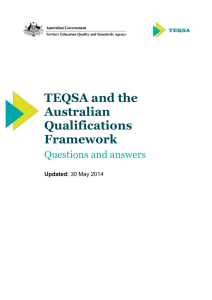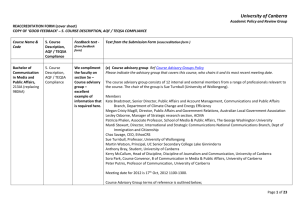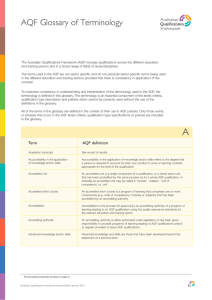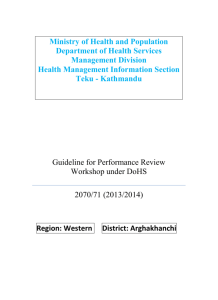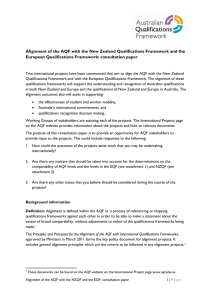DOCX, 124KB, 4 pages - Tertiary Education Quality Standards Agency
advertisement
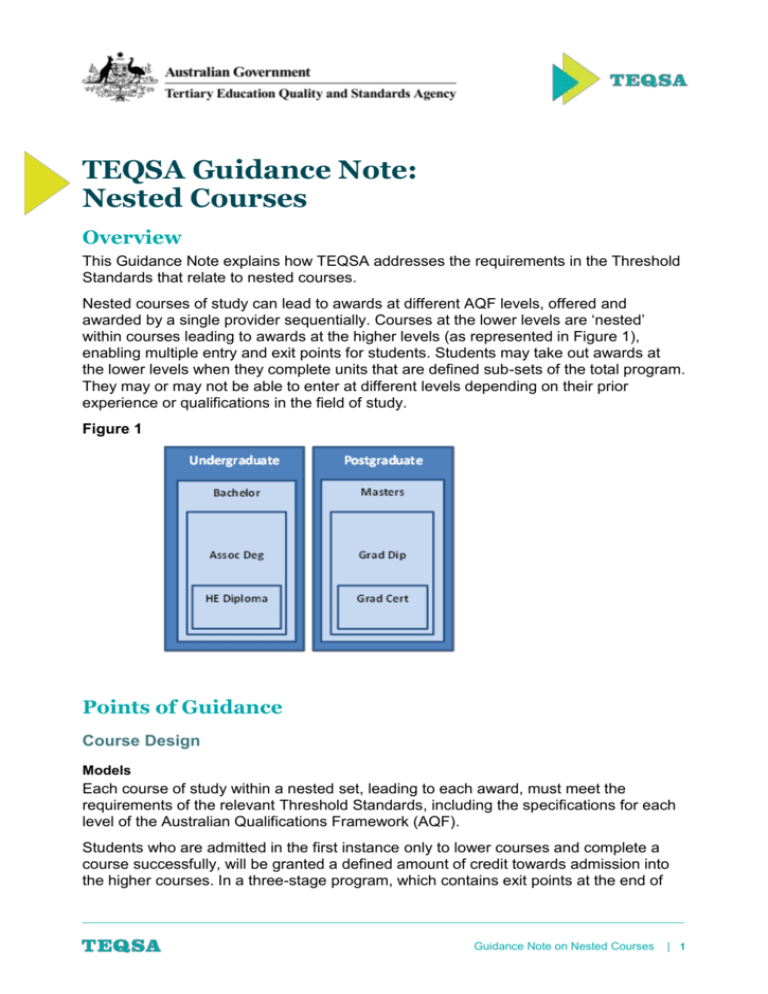
TEQSA Guidance Note: Nested Courses Overview This Guidance Note explains how TEQSA addresses the requirements in the Threshold Standards that relate to nested courses. Nested courses of study can lead to awards at different AQF levels, offered and awarded by a single provider sequentially. Courses at the lower levels are ‘nested’ within courses leading to awards at the higher levels (as represented in Figure 1), enabling multiple entry and exit points for students. Students may take out awards at the lower levels when they complete units that are defined sub-sets of the total program. They may or may not be able to enter at different levels depending on their prior experience or qualifications in the field of study. Figure 1 Points of Guidance Course Design Models Each course of study within a nested set, leading to each award, must meet the requirements of the relevant Threshold Standards, including the specifications for each level of the Australian Qualifications Framework (AQF). Students who are admitted in the first instance only to lower courses and complete a course successfully, will be granted a defined amount of credit towards admission into the higher courses. In a three-stage program, which contains exit points at the end of Guidance Note on Nested Courses | 1 each stage, this would typically entail one third credit being granted for completion of each level. However students who are enrolled directly into the higher course at the outset are not granted credit for completion of each level, and proceed through the entire program of study, unless they decide to exit at a lower level. The first scenario is often referred to as an ‘opt in’ model, and the second is referred to as an ‘opt out’ model. Principles It follows from the Standards that, in the examples given in the diagram: In the nested programs: o the course of study leading to the Bachelor or Master degree must meet the specified learning outcomes in the AQF for Bachelor or Master degree o the course of study leading to the Associate Degree or Graduate Diploma must meet the specified learning outcomes in the AQF for Associate Degree or Graduate Diploma o the course of study leading to the Diploma or Graduate Certificate must meet the specified learning outcomes in the AQF for Diploma or Graduate Certificate. Students who are enrolled in a lower course at the outset, but have the option of continuing on to complete the higher courses in the set, must achieve the learning outcomes for their initial course in the first instance, while at the same time positioning themselves to achieve the learning outcomes for courses leading to awards at higher levels if they proceed through the nested sequence. This applies regardless of whether the course conforms to an ‘opt in’ or ‘opt out’ model. Providers must ensure that the inclusion of subjects and subject elements at lower levels does not undermine the integrity of the highest course being delivered. This issue goes to the level of each subject, its content, its teaching staff and its assessment. The greater the proportion of subjects with learning outcomes below the AQF level of the course, the greater the risk that the course will not meet the course accreditation standards. In assessing a course proposal, TEQSA needs to be able to see clearly where each of the learning outcomes for each course (and each of the AQF level specifications) is delivered and assessed, bearing in mind that: many of the learning outcomes specified in the AQF for the awards in a nested package will be common some can only be progressively developed over time, with the groundwork for the more advanced learning outcomes being laid at the earlier stages. Where providers are presenting nested courses for assessment, it will assist TEQSA if an explanation or mapping is provided that shows how course learning outcomes that relate to the various AQF and course – specific learning outcomes are distributed throughout the entire program. Guidance Note on Nested Courses | 2 Staff qualifications Under PCAS 4.2, staff members who teach in the course of study must be qualified to at least one Qualification Standards level higher than the course of study being taught or with equivalent professional experience. TEQSA interprets ‘the course’ broadly to mean the entire course put forward for accreditation in an ‘opt-out’ model. Therefore, the first year of an opt-out nested bachelor course should be taught by staff with at least a Level 8 qualification (or equivalent) and the first year of an opt-out nested Masters course should be taught by staff with a doctorate (or equivalent). Where equivalent professional experience is claimed, the provider should have formal criteria for evaluating this to ensure that they meet the requirement for equivalence in CAS 4.2 (see forthcoming Guidance Note on staff qualifications and professional equivalence). However in the case of a purely opt-in model nested suite, where all incoming students are enrolled initially in, say, an AQF 8 course, classes composed exclusively of students currently enrolled in an AQF 8 course (e.g. Graduate Diploma, Graduate Certificate) could be taught by staff qualified at AQF 9 (or higher) or equivalent. But where a provider elects to mix opt-in and opt-out models, and teach students enrolled at different levels within the one class, then the teaching staff would be required to have AQF 10 qualifications or equivalent. Admissions Criteria Applicants may be admitted into any of these courses on the basis of prior academic achievement, or in some cases equivalent professional experience. Where applicants are admitted to any of these courses with advanced standing, based on prior academic achievement, the provider must be able to demonstrate to TEQSA that it has taken into account the comparability and equivalence of the learning outcomes, volume of learning, program of study including content and learning and assessment approaches, with those of the provider’s own course (Qualifications Standard 3.5). Where admission is on the basis of professional experience, providers must have reason for confidence that students will be able to achieve the academic standards required, bearing in mind that professional experience may not equip applicants with academic study skills. Above all, the provider must be able to demonstrate that all students admitted to any course have sufficient grounding in knowledge and skills to be able to achieve the learning outcomes of each course in the time available, and taking into consideration the course design. Students must be required to and have sufficient grounding to complete all the units that are necessary for them to achieve the course learning outcomes, given their different starting points in terms of prior knowledge and skills. Guidance Note on Nested Courses | 3 Resources Other relevant references Australian Qualifications Framework Second Edition January 2013 Addendum to the AQF Second Edition January 2013: Amended Qualification Type: Masters Degree (May 2014 - replaces pages 59-62 of the AQF Second Edition January 2013 Clustered Qualifications: An Explanation (AQFC November 2012) Proportion of Components of a Qualification at a Level: An Explanation (AQFC November 2012 Terminology The terms used to designate components of study and sequences of study vary between providers. One provider may use ‘course’ to designate a sequence of components, where another provider would use ‘program’. Other providers use ‘course’ to designate the components, equivalent to ‘module’, ‘subject’ or ‘unit’. In this Guidance Note, the word ‘course’ means a sequence of components (modules, subjects or units) that leads to the award of a qualification. This is consistent with the terminology of the Tertiary Education and Quality Agency Act 2011. TEQSA Contact For further information about or discussion of nested courses please contact your case manager in the first instance. Guidance Note on Nested Courses | 4
